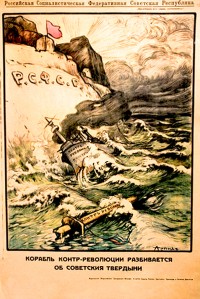Apsit, Aleksandr Petrovich (Apsītis, Aleksandrs)
Born 1880, Riga, Latvia, Russian Empire; died 1944 (location unknown), Germany
Alexandr Petrovich Apsit grew up amidst dire poverty and yet he received free instruction under the tutelage of the Saint-Petersburg painter, Lev Dmitriev-Kavkazskii. By 1902, Apsit was noticed by the popular journals, including Rodina [Motherland], Zvezda [Star], and Niva, for which he produced sketches. He also illustrated the publications of writings by A.M. Gorkii, N.S. Leskov, and A.P. Chekhov, as well as those by D. Bedny, I.S. Nikritin, and M.E. Saltykov-Shchedrin. Through these commissions he gained a stellar reputation, becoming one of the best-paid illustrators in the city.
He began to exhibit in 1903. In 1905, he made his foray into caricature drawings, which he produced for satirical journals, such as Dukh vremeni [The Sprint of the Times] and many others. Apsit's biographers indicate that the extent of his commitment [to the revolution] was stong. Regardless of his level of partisanship, in 1918 at the beginning of the Civil War, Apsit dedicated himself exclusively to the production of political posters for the Council of People's Commissars (SovNarKom). As a result, he established himself as one of the leading artists of early Revolutionary political posters. Near the end of the Civil War around 1921, he made his way back to Riga, Latvia and settled there. In 1939, Apsit moved to Germany where he died in 1944. Details of his death remain unknown.
Although Apsit created a number of canonical political posters of the early Soviet period, his contemporary critics including Viacheslav Polonski, and latter-day Soviet critics, assailed his work. In particular, fellow graphic artist Dimitri Moor chastised Apsit's posters for their stylistic heterogeneity. During the time of a relative liberalization under Nikita Khrushchev (1953-1964), it appears that Apsit's contribution to the development of the visual vocabulary of Soviet political posters was rehabilitated. In a seminal study of early revolutionary posters published in 1960, the author Boris Butnik-Siverskii introduced a more lenient, post-Stalinist assessment of Apsit's oeuvres, positioning him as one of the most important founders of the genre.
Sources & Citations
Bonnell, V. E. (1999). Iconography of power: Soviet political posters under Lenin and Stalin. Berkeley: University of California Press. (PP. 26, 32, 195, 286)
Milner, J. (1993). A dictionary of Russian and Soviet artists 1420-1970. Woodbridge: Antique Collectors' Club. (PP. 49-50)
Stites, R. (1991). Revolutionary dreams: Utopian vision and experimental life in the Russian revolution. New York: Oxford University Press. (P. 107)
White, S. (1988). The Bolshevik Poster. New Haven: Yale University Press. (PP. 25-32)
Vol'tsenburg, O.E., et al. (1970). Biobibligraphicheskii slovar' khudozhniki narodov SSSR (Vol. 1, P. 182). Moscow: Iskusstvo.
Butnik-Siverskii, B. S. (1960). Sovetskii plakat epokhi grazhdanskoi voiny, 1918-1921. Moskva: Izd-vo Vsesoiuznoi knizhnei palaty. (PP. 35, 45-50, 539)
Baburina, N. I. (1988). The Soviet Political Poster, 1917-1980. New York: Penguin. (bio, artist)
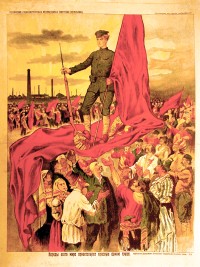
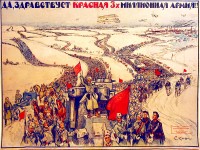
![PP 025: The first anniversary of the Red Army 1918-1919. "I am a farmer, the son of a worker, and I will be a soldier of the Red Army as long as I can hold a gun in my hands, against the hatred of the enemies of the workers." [Partial translation]](https://www.posterplakat.com/thumbs/the-collection/posters/pp-025/pp025-200x261.jpg)
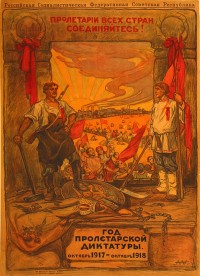
![PP 056: May 1 [Karl Marx wrote] "Workers have nothing to lose but they have the whole world to gain".](https://www.posterplakat.com/thumbs/the-collection/posters/pp-056/pp056-200x300.jpg)
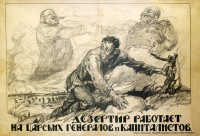
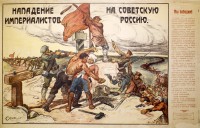
![PP 450: [At top, inside scroll] Why we need the Donetsk Basin
[Inside small scroll below just solder with red flag]
The coalfields surrounding Donetsk should be ours!
Red Army soldiers to arms! Workers and peasants to arms!
Crush the bands of the tsar's general Denikin who, for the benefit of kulaks and landlords,
wants to put to death by starvation the revolutionary peasants and workers.
[Partial translation]](https://www.posterplakat.com/thumbs/the-collection/posters/pp-450/pp450-200x297.jpg)
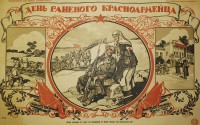
![PP 742: The Tsar, Priest and Rich Man [are] on the Shoulders of Working People.
Three lords of the world are riding on the shoulders of workers and peasants over barren, ruined earth, over bones and bodies of dead peasants.
These three lords are the Tsar, the Priest and the greedy, insatiable, rich Capitalist.
[Partial translation]](https://www.posterplakat.com/thumbs/the-collection/posters/pp-742/pp742-200x300.jpg)
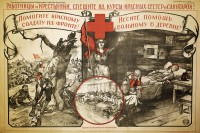
![PP 792: Organize Country Houses of Reading.
Learning is Light. Ignorance is Darkness. Knowledge is Power.
[Partial translation]](https://www.posterplakat.com/thumbs/the-collection/posters/pp-792/pp-792-catalog-image-196x300.jpg)
![PP 793: Organize Country Houses of Reading.
[Partial translation]](https://www.posterplakat.com/thumbs/the-collection/posters/pp-793/pp-793-catalog-image-200x300.jpg)
![PP 893: International.
Arise, ones who are branded by the curse, A whole world of starving and enslaved!
Our outraged minds are boiling,
Ready to lead us into a fight to the death.
We will destroy this whole world of violence Down to the foundations, and then
We will build a new world.
The one who was nothing will become everything! [Partial translation]](https://www.posterplakat.com/thumbs/the-collection/posters/pp-893/pp-893-catalog-image-200x300.jpg)
